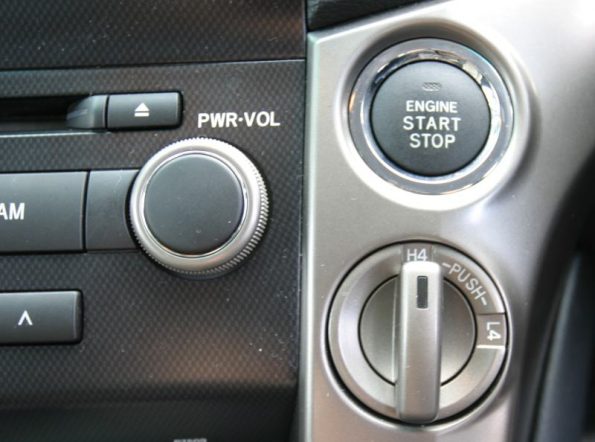Relay car theft, or ‘relay attack’ is when criminals use the keyless entry system of a car against itself by tricking the car into thinking the wireless remote is next to it. It works on cars where you can enter and start the car without using a key. More and more cars use these wireless systems because it removes the bulky lock barrel from the steering column that is a risk for knee injuries in a crash. It’s also more convenient for drivers.

The start/stop button on this Toyota Land Cruiser means it is at risk of a relay attack
How does a relay attack work?
You need three things:
- Your wireless key within transmitting distance of the car (sometimes up to 100m!)
- A person standing near the key with a device that tricks the key into broadcasting its signal
- A person standing near the car with a receiver that tricks the car into thinking it is the key
The person near the key uses a device to detect the key’s signal. This is relayed to the person holding the receiver which is then detected by the car as the key itself. It will open and start the car.
How can you stop a relay attack?
For relay car theft to work, your key must be able to be accessed via a wireless transmission. This means that if you put it in a place where it can’t receive a wireless transmission, like a microwave, a metal tin, your fridge or a Faraday sleeve or wallet, it won’t work for the would-be thieves. You can buy Faraday sleeves for your mobile phone to stop them receiving calls and for RFID credit cards to stop them being accessed. They’re usually less than $10.
Therefore, you won’t want to be leaving your key in the hallway overnight as the transmitter signals will pass through walls, doors and windows.
You can also provide physical barriers to thieves such as a wheel lock, locked gates or putting your car in a garage. Tracking devices will help recover your car but they won’t stop it from being stolen. A secondary immobiliser which requires a PIN to start adds another layer.
To recap, here’s how you reduce the risk of becoming a victim of a relay attack:
- Put your keys where they can’t transmit or receive
- Make sure your car is locked
- Add physical countermeasures
- Add a tracking device
- Keep your keys out of sight
- Make sure you have insurance
What vehicles are at risk?
Any vehicles with a push-button start are at risk. This includes almost all new cars and many new vans. Push-button start has been readily available on even mid-range cars for more than 5 years. Carmakers are working on systems to thwart the thieves but its likely that existing models will remain vulnerable. The measures that are being worked through are part of broader measures to ensure data security.
